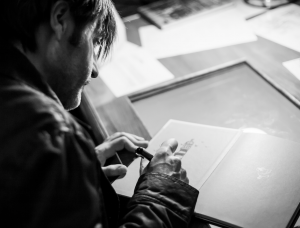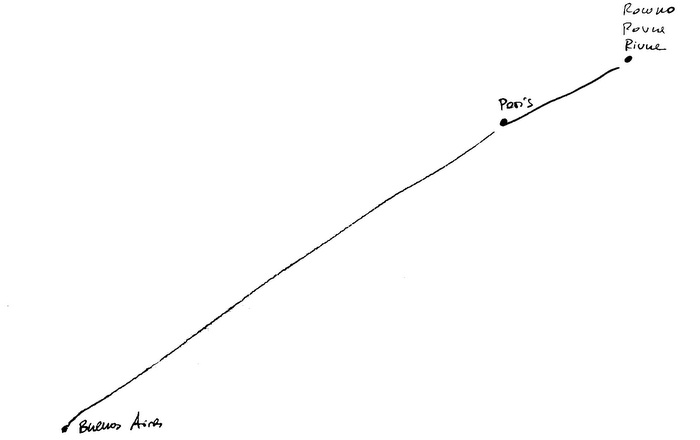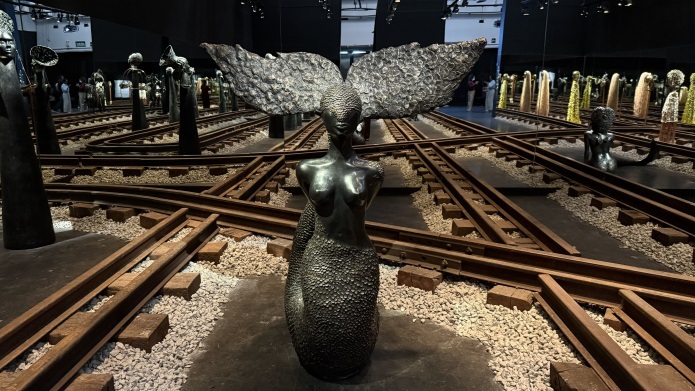 The Espacio Fundación Telefónica (Madrid) hosts the exhibition 'Dibujante Ambulante', which discovers the public the method of work of illustrator Paco Roca (Valencia, 1969) and the overview of what the comic is, as well as its creative process and illustration, from the conception of the idea to its implementation in the final stand.
The Espacio Fundación Telefónica (Madrid) hosts the exhibition 'Dibujante Ambulante', which discovers the public the method of work of illustrator Paco Roca (Valencia, 1969) and the overview of what the comic is, as well as its creative process and illustration, from the conception of the idea to its implementation in the final stand.
Considered the master of the invisible art, as some people define him, Roca is the cartoonist par excellence in Spain. The illustrator has been fulfilled his childhood dream, because he wanted to live drawing since childhood, " I began communicating through drawing long before speaking and of course writing and over time has become my way of expressing myself, I get in a natural way. To me, drawing is like the word for a writer. "
The winner of the 2008 National Comic Prize has immersed himself in various jobs over the years in various formats: advertising, graphic novel or newspaper. With all of them he has been enriched because, as he says, "I like to draw, but I like the most is to tell stories. And where those two things come together is in the comic book world."
Behind the Bullet
After his passing through Valencia and Bilbao, the exhibition Dibujante Ambulante now reaches Madrid, which runs through the work of the Valencian artist since 2000 and allows the public to come to his particular creative universe through sketches, notes, scripts, posters, publications and broadcast to a total of more than 200 pieces.
As the own illustrator explains, "the exhibition teaches everything behind the bullet, all that work documentation, sketching, making schemes that help me to know whether the story works or does not work."
Curated by the designer MacDiego, the exhibition aims to bring comic fans the working process of an artist, taking as an example the case of Roca, who scores the ideas in his travel journals and transforms a line into a bullet through programs computer.
Long process
To Roca this process is very long, "I can take a year and a half" because "to tell a story one needs a lot of reflection. Parts of a script that has to be reflected in the sketches, then you have to go back to tell it when drawing it, when entintas and give it some color in a continuous begin and end the story. Each step brings something new to the story. "
Visitors who go to the Fundación Telefónica will find a dynamic exhibition design that has two important parts: comics and media contributions. The tour starts with his most famous work, Arrugas, with which he won in 2012 the Goya award for Best Adapted Screenplay and that is also shown in a display case.
Out of Spain
But they are also some of the illustrations published abroad, in Italy and France, unknown by the Spanish public; while he rescues work Memorias de un hombre en pijama, he made for the Sunday magazine V of The Provinces.
Finally, the exhibit has a space dedicated to Viñetas de Vida, a cooperative project of Intermón Oxfam, in which the NGO has sent nine artists at different points in Asia, Africa and Latin America. Paco Roca has been one of the chosen and that is why the book cover shown, the travel diary and a couple of sketches of the history that he has performed in Mauritania are exhibited.
Symposia
The exhibition is complemented by four symposia in which it will be discussed the manners, autobiographical, war comic, and the role of artists as complainants social inequalities.
November 20th , at 19.30: Andanzas de un hombre en pijama, by Paco Roca, Borja Crespo and Gregorio Belinchon.
December 11th , at 19.30: El cómic autobiográfico by Juanjo Sáez, Raquel Córcoles, Carlos Carrero and Paco Roca.
January 2015: Narrar solidariamente by Paco Roca and Miguel Gallardo.
February 2015: La guerra en viñetas y fotogramas, by Joe Sacco and Paco Roca.
In 2015 there will be scheduled two educational workshops on animation storyboard for families and youth, with dates to be determined: Cuando tú y yo teníamos la misma edad y Contar el pasado, conocer el presente.
Source: Hoyesarte














